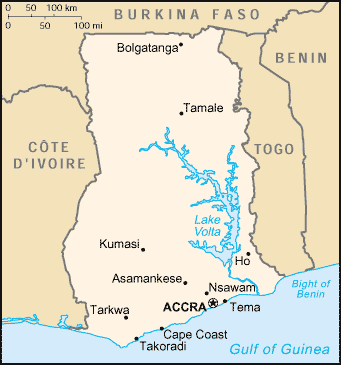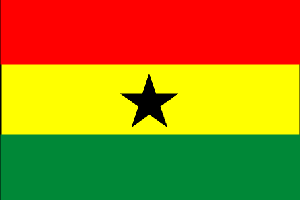
|
Ghana
Background:
Formed from the merger of the British colony of the Gold Coast and the Togoland
trust territory, Ghana in 1957 became the first country in colonial Africa to
gain its independence. A long series of coups resulted in the suspension of the
constitution in 1981 and the banning of political parties. A new constitution,
restoring multiparty politics, was approved in 1992. Lt. Jerry Rawlings, head
of state since 1981, won presidential elections in 1992 and 1996, but was
constitutionally prevented from running for a third term in 2000. He was
succeeded by John Kufour.
Location:
Western Africa, bordering the Gulf of Guinea, between Cote d'Ivoire and Togo.
Area: Total: 239,460 sq km, land: 230,940 sq km, water: 8,520 sq km.
Area - comparative: Slightly smaller than Oregon.
Land boundaries: Total: 2,094 km, border countries: Burkina Faso 549 km, Cote
d'Ivoire 668 km, Togo 877 km.
Coastline: 539 km.
Climate and Terrain:
Climate: Tropical; warm and comparatively dry along southeast coast; hot and
humid in southwest; hot and dry in north.
Terrain: Mostly low plains with dissected plateau in south-central area.
Natural resources: Gold, timber, industrial diamonds, bauxite, manganese, fish,
rubber, hydropower.
People:
Population: 20,244,154.
Ethnic groups: Black African 98.5% (major tribes - Akan 44%, Moshi-Dagomba 16%,
Ewe 13%, Ga 8%, Gurma 3%, Yoruba 1%), European and other 1.5%.
Religions: Indigenous beliefs 21%, Muslim 16%, Christian 63% .
Languages: English (official), African languages (including Akan,
Moshi-Dagomba, Ewe, and Ga).
Note: There are 9,500 Liberians, 2,000 Sierra Leoneans, and 1,000
Togolese refugees residing in Ghana.
Government:
Government type: Constitutional democracy .
Capital: Accra.
Independence: 6 March 1957 (from UK).
Economy overview:
Well endowed with natural resources, Ghana has roughly twice the per capita
output of the poorer countries in West Africa. Even so, Ghana remains heavily
dependent on international financial and technical assistance. Gold, timber,
and cocoa production are major sources of foreign exchange. The domestic
economy continues to revolve around subsistence agriculture, which accounts for
36% of GDP and employs 60% of the work force, mainly small landholders.
Excessively expansionary monetary and fiscal policy prior to the 2000 elections
led to accelerating inflation in early 2001.
GDP - composition by sector: Agriculture: 36%, industry: 25%, services: 39%.
Statistics:
Telephones - main lines in use: 240,000.
Telephones - mobile cellular: 150,000.
Radio broadcast stations: AM 0, FM 49.
Radios: 12.5 million.
Television broadcast stations: 10.
Televisions: 1.9 million.
Internet users: 200,000.
Railways: Total: 953 km.
Highways: Total: 38,940 km, paved: 9,346 km, unpaved: 29,594 km.
Airports: 12, with paved runways: 7, with unpaved runways: 5.
Return to Visiting Locations
|

